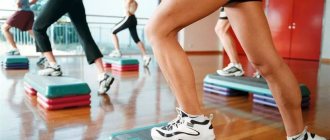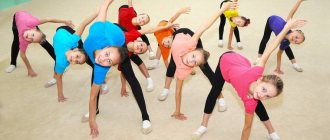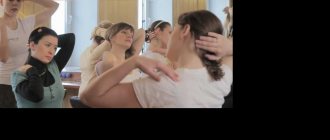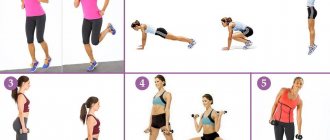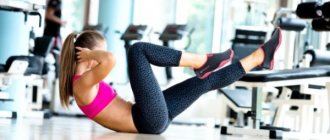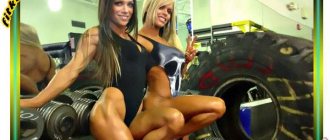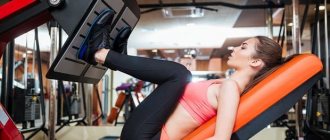Advantages of step aerobics
Exercise has a number of benefits, one of which is effective fat loss. An hour-long workout at a good pace helps burn up to 500 kcal. The main load falls on the lower part of the body. What muscles are actively working? All parts of the thigh, muscles of the buttocks and lower legs are pumped, which makes the legs slimmer and more prominent.
How else is step aerobics useful, besides the fact that it improves your figure?
- Compared to other types of cardio exercise (running, jumping rope), exercises with a platform cause less damage to joints.
- Aerobics trains the cardiovascular system, increases endurance, and improves coordination.
- Changing the height of the apparatus allows you to individually change the load and degree of difficulty of the workout.
- Jumping is not only effective cardio, but also a good stretch.
- Classes are suitable for effective weight loss at home: for a successful workout you need step, invigorating music and a great mood.
The essence of step aerobics
This group lesson was invented by the American Jean Miller, mainly for weight loss. It all started back in the 80s, when people were already tired of regular aerobics on the floor, but had not yet fallen in love with heavy interval classes like functional training. Back then, step aerobics was something that can often be seen in old films and videos - leg warmers, swimsuits, bright platforms and disco from speakers.
Since the days of Jean step, step has evolved. Almost every leading instructor brought something different to the program. There are no uniform standards here . Steps are used, but many complement them with signature arm movements, dance steps, jumps or something else. Each instructor makes a unique product. Clients say that you can either love or hate step; a lot depends on the trainer.
Step is a group lesson using special stable platforms:
- first, aerobic warm-up is performed, steps on the floor;
- then – light preliminary stretching of the muscles of the legs and back;
- then the group learns steps and their combinations using platforms;
- at the end he dances a series of steps several times, does abdominal exercises, and stretches.
The lesson is based on the basic steps of aerobics - mambo, step-touch, grapevine, kick. Added “steps” - that is, steps onto the platform.
The load is adjusted by changing the height of the platform and the speed of the ligament.
© ludzik — stock.adobe.com
Contraindications
Despite all the advantages, step aerobics has contraindications. Intense training is risky for those with health limitations:
- diseases of the cardiovascular system;
- diseases of the joints, spine, dysfunction of the musculoskeletal system;
- recent injuries and surgeries;
- severe excess weight;
- hypertension;
- varicose veins of the lower extremities;
- chronic liver diseases;
- pregnancy and the first 3 months after birth.
Advantages and benefits of step aerobics
- First of all, this is an excellent cardio workout that helps strengthen the cardiovascular system. With regular exercise, the volume of the heart muscle increases, the density of capillaries increases, the risk of heart disease and heart attacks decreases, and blood pressure normalizes.
- When doing step aerobics, oxygen supply to tissues improves, hemoglobin levels increase and the volume of circulating blood increases. Thanks to this, nutrients are better supplied to tissues and cells, muscles and joints are restored faster.
- With active flexion and extension of the knee joints, the production of joint fluid or “lubrication” of the joints is activated, due to which they become more mobile.
- Active training accelerates metabolic processes in the body and also has a positive effect on the production of the hormone calciotonin, which is responsible for the body's absorption of calcium.
- Step aerobics improves muscle tone, helps burn subcutaneous fat, and makes the body slim and fit.
- Lung capacity increases noticeably and pulmonary circulation improves.
Features of selecting a step platform
Safe and reliable sports equipment is one of the components of a successful training result. There are several rules for choosing the right platform.
- The step platform must be made of durable plastic and covered on top and bottom with an anti-slip rubberized layer.
- The length should be between 1 and 1.5 meters. Stand on the board and place your feet shoulder-width apart. If you are comfortable and there is no fear of falling from it, the length is chosen correctly.
- The width should be approximately 2 foot lengths (at least 40 cm). You can trip on a narrow platform, and it’s inconvenient to exercise on a wide platform.
- For effective step aerobics, the height of the step is important: the higher, the greater the load. Beginners and short people are advised to choose a low stepper height. It is even better to purchase a model with an adjustment function.
If you can’t buy a projectile in a store, you can make it yourself from wood. A strong wooden or plastic box of the required size will also serve as a platform.
Types of training
Step aerobics is not just boring steps and jumping on a platform. Incendiary music, interesting combinations, dance and strength elements make the classes varied and exciting. Depending on the level of difficulty and techniques used, training is divided into several categories.
- Basic Step - the initial level, where you get acquainted with aerobics, learn basic movements and simple combinations. If you decide to study on platforms, it is better to start from the basic level.
- Advanced Step - a lesson for advanced students, including complex combinations, jumps and turns. The training takes place at an intense pace, the load is higher than the basic one.
- Power Step - power step aerobics. These classes use strength exercises with weights, which allows you not only to lose fat, but also to pump up muscles.
- Step Combo combines dance moves with steps. Fast-paced classes are suitable for trained athletes with good coordination.
- Step Interval - interval training with a change of pace that effectively burns excess fat.
- Dance Step - dance lesson. Emotionally intense workouts improve your mood, develop flexibility and eliminate unnecessary calories.
You can master step aerobics not only in group classes in the gym, but also in your own home environment. Don’t rush to cover all areas at once, start practicing gradually, carefully monitor your well-being. If you experience shortness of breath, dizziness or increased blood pressure during exercise, it is better to slow down.
Do not forget to follow the technique of performing the exercises: movements are carried out due to the work of the leg muscles, the back is straight.
It is especially important: the foot is placed completely on the platform, the heels should not hang over the edge.
Step aerobics - benefits and harms
This type of fitness, despite its enormous benefits, has a number of contraindications - joint injuries, diseases of the spine and joints, diseases of the cardiovascular system, arrhythmia and angina, and renal failure.
Even in the absence of contraindications, you need to be careful not to cause harm to the body. Overtraining should be avoided, so it is better to attend classes every other day, taking a break. To avoid injury, you must follow safety precautions on the step platform by standing on it with your full foot. It is very important to choose the right shoes - you need to train in sneakers with thick soles that absorb shock well.
By being careful, closely following the trainer’s movements and practicing according to the recommendations, you can improve your health, figure and posture.
Catalog
Steps without changing the leading foot
These are basic simple movements, each new beat begins with the supporting leg, no matter how many times you repeat it.
- Basic step - step straight ahead with your leading foot, then the other foot onto the step platform, return with both feet in turn to the floor.
- V-step differs from Basic in that the movements are performed in the corners of the step, i.e. in the “standing on the platform” position, your legs should be placed at opposite ends. Returning to the floor, bring your legs together.
- A-Step is similar to V-step, but the movement begins from the “standing on the step” position: step down twice, put your feet apart, rise back, put your feet together.
- Mambo - step one foot forward onto the board, return the foot back to the floor, and step in place with the other foot.
- Over - a movement with a transition to the other side of the board: approach the step from the side, raise one leg onto the platform, step with the second leg, at the same time turn your back forward and return first the first leg, and then the second to the floor back.
- Straddle includes Straddle Up and Straddle Down. Place the step between your legs, short side forward. For Straddle Up, take the starting position “feet on the floor on opposite sides of the step platform”, then do two climbs onto the board, two descents back to the floor. To perform Straddle Down, take the starting position “standing on the board”, step twice onto the floor on opposite sides, and return.
- Up Up Lunge - rise onto the board with both feet, touch the toes of both feet to the floor twice in turn, and lower to the floor.
Steps with changing leading foot
Exercises with changing the leading leg involve starting each next step with the other leg. You can diversify your workouts with a set of complicated exercises:
- Tap up - step on the opposite edge of the platform with your first foot, place your second foot and touch the step with your toe, and return your feet to the floor one by one. Repeat the exercise on the second leg.
- Knee up is similar to the previous option, but raise the second leg, bent at the knee (turn the thigh parallel to the floor, point the toe down), return to the starting position on the floor.
- Kick - step one foot into the corner of the step, kick with the second straight leg in the air, step back with the same leg and return the first leg to the floor.
- Curl - the movements of the leading leg are similar, raise the second leg in an overlap (point the knee to the floor, reach the buttocks with the heel), go back.
- Lift - rise with your supporting leg to the opposite edge of the platform, swing the second leg straight (front lift), to the side 45 degrees (lift side) or back (Back Lift), descend alternately to the floor;
- L-step - step with the first foot to the other edge of the step, lift the second leg, bent at the knee, and place it on the side of the platform. Shift your body weight, lift your leading leg, bent at the knee, and step back onto the board. Raise the second leg bent at the knee again and return it to its original position, step the leading leg back to the floor.
This is not a complete list of movements, but only the main steps, on the basis of which there are many other elements and connections.
Step aerobics is an interesting type of fitness that really helps you lose weight and get in shape.
Don't be afraid to try, you can start with regular walking. Set a goal, go towards it, and the result will not take long to arrive. The main thing is to listen to yourself, increase the load gradually so that your training brings both joy and benefit. Music for step aerobics
